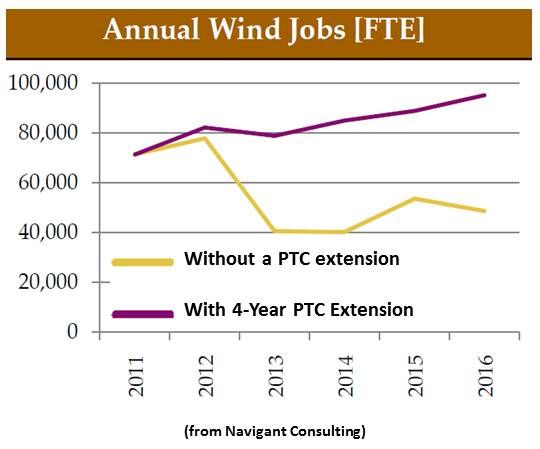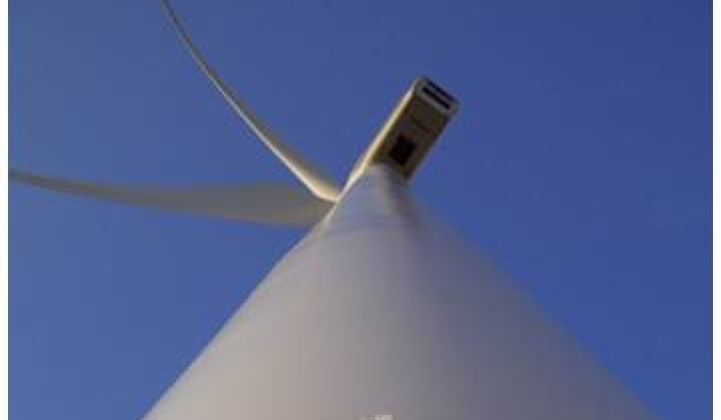1.) Big Numbers in Wind Deployments, Little Support. The U.S. industry overcame the economy’s bad news and kept building in 2011. This year’s installations will likely top out at approximately 7 gigawatts and the cumulative number will go beyond 45 gigawatts, the second largest in the world and the equivalent of 45 monstrous nuclear or coal plants. Colorado set a record by providing 55.6 percent of the state’s power on one day in October and wind helped Texas keep the lights on when the state’s fossil fuel plants failed in February.
Yet the industry is priming itself for a downturn in 2013. Unlike federal subsidies for the fossil and nuclear industries, incentives for renewables must be extended periodically. Because Congress appears ready to ignore the wind industry’s need for stability and to delay extension of the vital production tax credit (PTC) past 2012, 78,000 jobs and a $15.6 billion contribution to the economy are at risk.

2.) Impact of Fukushima on Wind. Two wind stories followed the March Japanese tsunami and nuclear meltdown.
First, wind turbines on Japan’s Pacific coast kept producing power. The small installation’s electricity didn’t do a lot. But the ability of wind technology to withstand what nuclear technology could not said it all.
More importantly, German Chancellor Angela Merkel, a physicist by training and not given to rash decisions, announced Germany will turn away from the inordinate costs and risks of nuclear power and will rely instead on its distributed solar and its enormous North Sea offshore wind potential.
3.) The Pacific Northwest Rules. Shepherd’s Flat, the world’s biggest on-land wind project, went into construction in Oregon, helped by a DOE loan guarantee and big financial backing. One of the backers, Google, invested over a quarter of a billion dollars in wind in 2011 between Shepherd’s Flat and California’s Alta Wind Energy Center.
Washington grid operator Bonneville Power, faced with an abundance of resources, chose hydropower over wind. A group of wind developers sued. The court’s landmark decision supported wind’s contention that grid operators must expand their integration of renewables.

4.) Wind Technology Continues to Improve. Wind is the most mature renewable but still evolving. Two advances demonstrated in 2011 will soon resolve some big challenges. Radar technologies, combined with computing power, will eliminate conflicts with defense and air traffic control systems, as well as with bird and bat endangerment. And new turbines like the GE 1.6-megawatt extended rotor machine are already cost-effectively harvesting slower winds and opening up new regions like the U.S. Southeast.
5.) Offshore Wind Advances and Retreats. European wind makers joined to design turbines with 10-megawatt to 20-megawatt capacities that are durable enough to face the daunting ocean environment. They should be ready for testing by mid-decade and deployment by 2020.
A European-U.S. venture successfully put a 2-megawatt, next-generation floating turbine to work 350 kilometers into the Atlantic Ocean off the coast of Portugal.
Studies clarified the practicality of and challenges in delivering offshore wind generated electricity via subsea transmission, as well as how and where to integrate it into the land system.
The $5 billion Atlantic Wind Connection transmission backbone got multiple regulatory approvals.

The long-suffering Cape Wind project got its final regulatory go-ahead, only to be stopped again by an FAA conflict. (Insiders say it will soon be cleared.)
The political gridlock blocking the PTC’s extension also impedes U.S. offshore project financing initiatives. NRG Energy this year pulled backing of Bluewater Wind. Other investors grew hesitant.
6.) China Takes Over Wind Leadership, Retools. Early this year, China assumed a position of world leadership in cumulative wind capacity from the U.S., although its rate of growth slowed. The National Development and Reform Commission (NDRC) announced more rigorous turbine standards and State Grid implemented transmission system interconnection upgrades.
Higher standards will make the Chinese industry stronger in time, but for now, they are driving consolidation. Transmission upgrades will ultimately allow integration of more renewables, but at the current juncture, Chinese wind turbine makers are scrambling to add the necessary technologies.

7.) Sino-U.S. Wind War. Uneasy trade relations with China exploded this year when AMSC, a U.S. advanced technologies provider, sued Sinovel, China’s leading turbine manufacturer.
The confession and conviction of a former employee of AMSC subsidiary WindTec make it hard not to believe that Sinovel is liable. The employee was convicted of intellectual property (IP) theft and collusion to transfer software designed to meet the new transmission system regulations.
Wind companies everywhere will profit from a settlement, but it could cost Sinovel billions of dollars. Also at stake is the validity of contracts in China. The outcome will be precedent-setting and could impact U.S.-China relations
8.) Latin American Wind: A New Frontier. Vestas, the world’s leading turbine maker, built manufacturing facilities in Brazil. Goldwind and Mainstream Renewables closed a deal in Chile. Mainstream Renewables did a deal in Ecuador. EDF and Clipper Windpower are building so aggressively in Mexico’s Tehuantepec Isthmus that the rural region is overwhelmed with traffic problems.
The point: Latin American countries have smoothed regulatory tie-ups, instituted incentives, and streamlined siting -- issues still unresolved in the U.S. that are driving pioneers to new markets.

9.) Wind Fights Back in the PR Battle. As the fossil fuels industry lost market share to wind in recent years, media misinformation discrediting wind proliferated. The wind industry started responding this year.
2011 saw the debut of WindTV, SaveUSAWindJobs.com (a website describing wind’s economic benefits), and WindMade, a label authenticating products manufactured with wind-generated electricity. And the wind industry called on its advocates to spread the word about the value of wind power.



